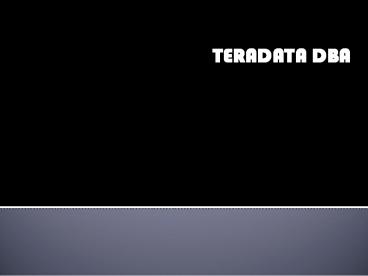Teradata - PowerPoint PPT Presentation
Title: Teradata
1
- TERADATA DBA
2
Teradata Architecture
- Teradata architecture is based on Massively
Parallel Processing (MPP) architecture. The major
components of Teradata are Parsing Engine, BYNET
and Access Module Processors (AMPs). The
following diagram shows the high level
architecture of a Teradata Node.
3
(No Transcript)
4
COMPONENTS OF TERADATA
- Node
- Parsing Engine
- Message Passing Layer
- Access Module Processor (AMP)
5
NODE
- It is the basic unit in Teradata System. Each
individual server in a Teradata system is
referred as a Node. A node consists of its own
operating system, CPU, memory, own copy of
Teradata RDBMS software and disk space. A cabinet
consists of one or more Nodes.
6
Parsing Engine
- Receive the SQL query from the client
- Parse the SQL query check for syntax errors
- Check if the user has required privilege against
the objects used in the SQL query - Check if the objects used in the SQL actually
exists - Prepare the execution plan to execute the SQL
query and pass it to BYNET - Receives the results from the AMPs and send to
the client
7
Message passing Layer
- Message Passing Layer called as BYNET, is the
networking layer in Teradata system. It allows
the communication between PE and AMP and also
between the nodes. It receives the execution plan
from Parsing Engine and sends to AMP. Similarly,
it receives the results from the AMPs and sends
to Parsing Engine.
8
Access Module processor
- AMPs, called as Virtual Processors (vprocs) are
the one that actually stores and retrieves the
data. AMPs receive the data and execution plan
from Parsing Engine, performs any data type
conversion, aggregation, filter, sorting and
stores the data in the disks associated with
them. Records from the tables are evenly
distributed among the AMPs in the system. Each
AMP is associated with a set of disks on which
data is stored. Only that AMP can read/write data
from the disks.
9
STORAGE ARCHITECTURE
- When the client runs queries to insert records,
Parsing engine sends the records to BYNET. BYNET
retrieves the records and sends the row to the
target AMP. AMP stores these records on its
disks. Following diagram shows the storage
architecture of Teradata
10
(No Transcript)
11
- Oracle training in marathahalli
- http//www.traininginmarathahalli.in
PowerShow.com is a leading presentation sharing website. It has millions of presentations already uploaded and available with 1,000s more being uploaded by its users every day. Whatever your area of interest, here you’ll be able to find and view presentations you’ll love and possibly download. And, best of all, it is completely free and easy to use.
You might even have a presentation you’d like to share with others. If so, just upload it to PowerShow.com. We’ll convert it to an HTML5 slideshow that includes all the media types you’ve already added: audio, video, music, pictures, animations and transition effects. Then you can share it with your target audience as well as PowerShow.com’s millions of monthly visitors. And, again, it’s all free.
About the Developers
PowerShow.com is brought to you by CrystalGraphics, the award-winning developer and market-leading publisher of rich-media enhancement products for presentations. Our product offerings include millions of PowerPoint templates, diagrams, animated 3D characters and more.































